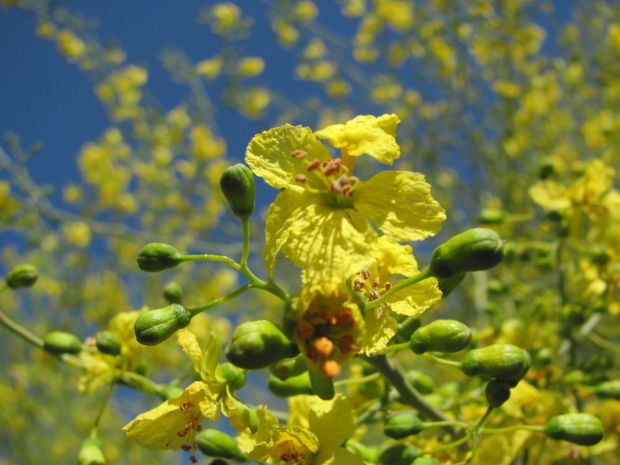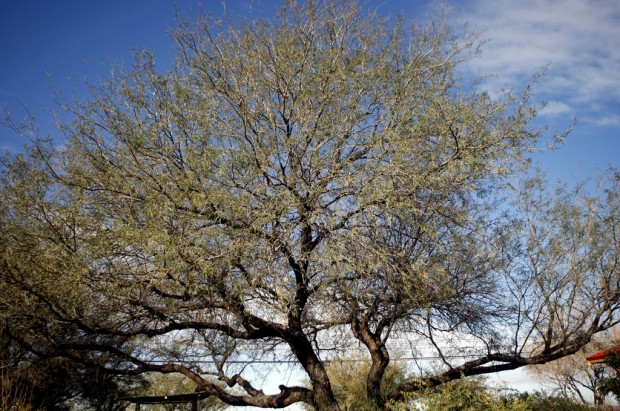With summer around the corner and temperatures still cool, this is a great time to think about planting shade trees. If you have a larger property, you may have room for trees over 30 feet tall, which can provide great habitat for animals and a pleasingly cool microclimate for you.
When planting large trees, it’s critical to plan the space correctly. Many of these trees will ruin hardscaping and even foundations with their roots, so plant them well away from structures. You also want to avoid any problems if the tree dies or is blown over by the wind. It is also critical to make sure the tree’s roots are well-established. Check out my articles "10 tips for healthy tree roots in Tucson" and "How to care for your Tucson trees" for tips on how to make your trees as happy and healthy as possible.
The trees I have listed here are all keystone species — that is, critical species to our desert ecosystems — so planting any of them will be extremely beneficial for the critters you share your yard with.

Mature velvet mesquite trees can grow over 40 feet tall and are a great native tree option if you have the space.
Velvet mesquite (Prosopis velutina) is one of our familiar desert trees, and most are on the low side in their native habitat. But when given some supplemental water, these trees can grow up to 50 feet tall. They are excellent trees for humans and animals alike, as they provide beautiful lacy shade, habita, and food. They are also nitrogen fixers, and will take in nitrogen gas from the air and put it into the soil where other plants can take advantage of it.
Note that their roots will be aggressive and will get into your planter boxes, plumbing, sidewalks and even walls (if you have a water leak — this happened to me). Taking this into account, plant them a good distance away from any structures.
Cottonwood (Populus fremontii) can grow up to 90 feet in height and is native to our riparian areas. I list this tree with a lot of caveats. First, it will not survive in yards, even with irrigation, once it grows to its full height. These trees are huge and they only live their full lifespan if they are near a creek or wash. Second, their roots are very invasive and will seek out water anywhere — your plumbing, your septic, your irrigation, etc. Third, they also have a tendency to die and possibly fall over when they have reached their maximum lifespan. For these reasons they should never be planted within a few hundred feet of any structure and should only be planted in an area where they will be able to reach a natural water source once their roots are established.
So why are they on this list? If you have a large property with a creek or wash, you can try to plant a couple of these trees and see if they make it. They are excellent habitat trees for hundreds of native species, both large and small thanks to their ability to create microclimates for other plants and animals that would otherwise never thrive. And they are spectacular — their small leaves glitter in the sun and turn gold in the fall, their gray trunks grow weathered and textured with age, and they provide deep, glorious shade.
Emory oak (Quercus emoryi) is native to higher elevations in the Sonoran and Chihuahuan deserts. It grows slowly, up to 50 to 100 feet but usually tops out at around 60 feet in our area. In many areas it grows as a shrub-like tree. In the landscape, it will need some supplemental watering to get it to grow taller. It’s a deciduous tree, but provides good shade in the summer. Deer love to eat this tree, so you will need to protect it while it’s younger and vulnerable to damage. Once it’s a bit bigger, it is a great habitat tree for numerous animals of varying sizes. The acorns are edible, and Native American tribes ground them into meal to eat.

The blue palo verde can reach up to 30 feet in height and provides habitat for many native animals. It also has lovely flowers in the spring.
Blue palo verde (Parkinsonia florida) is another familiar tree that can get 40 to 50 feet tall with proper care. It grows fairly quickly, too. The beautiful flowers cheer up springtime, and as with other native trees it’s great for birds and pollinators, particularly native bees. The seed pods are edible, too, and are great for both small animals and humans. It provides lacy shade, and is a great tree for distant areas of your yard where you want to plant shade-tolerant plants. It’s also a legume, and will fix nitrogen from the air into the soil.
Arizona cypress (Cupressus arizonica) is native to elevations of 3,000 feet or higher in the Sonoran Desert. It can grow to 60 feet, and is a relatively fast grower. Like many of these larger trees, it requires a lot of space; it will also require deep monthly supplemental watering to survive in the low desert. It’s a great tree for wildlife, as its seeds are eaten by various small mammals, and the trees provide habitat and nesting for birds. It’s also a great opportunity to plant an evergreen tree; keep in mind that it will provide shade throughout the year when considering placement. These trees are susceptible to bark beetles when drought-stressed, so plan for supplemental watering throughout its lifetime.
Arizona white oak (Quercus arizonica) can grow up to 50 feet tall with good irrigation. It’s a tree native to the Sonoran and Chihuahuan deserts, and is usually present at higher elevations like canyon slopes. The tree is essentially evergreen in our climate, and will provide good shade. Like other oaks, it is an excellent habitat tree for all manner of animals of varying sizes. It can be tricky to find these trees for sale, but Spadefoot Nursery has had them in the past.
A short video featuring some beautiful flowers blooming now in Tucson for spring.







